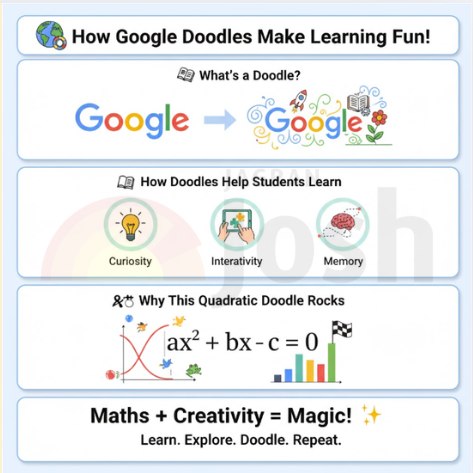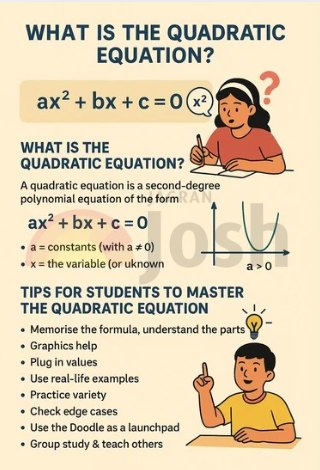Google Doodle: On 12 November 2025, Google has launched a special animated Doodle titled “Learning the Quadratic Equation (India)” a vibrant tribute to one of the most searched and wide-ranging equations in mathematics, the quadratic equation. For students across India, this Doodle is more than just a decorative splash on the search homepage; it's an invitation to explore a fundamental concept in algebra in a fun, visual way. Whether you’re just stepping into higher secondary maths, preparing for board exams, or simply curious about how maths pops up in real life, this Doodle offers a fresh lens.

What is a Doodle?
A “Doodle” is what Google calls its special homepage artworks and interactive animations that mark anniversaries, celebrations, new discoveries, and topics worth spotlighting. The “Learning the Quadratic Equation (India)” Doodle uses animation to highlight how the equation ax² + bx + c = 0 plays out in the world around us.
For students, engaging with a Doodle means something more dynamic than simply reading a textbook: it’s a visual curiosity-trigger, a way to see maths in action. The Doodle emphasises the themes of mathematics, visual learning and active exploration.
It shows how maths is not just symbols on a board, but a powerful tool used in physics, engineering, business and more.
What Will Students Gain From This Doodle?
-
Visual Understanding: The Doodle helps you see the quadratic equation abstract symbols (“ax² + bx + c = 0”) turn into animations and real-world analogies making the concept more memorable.
-
Connection to Real Life: The Doodle points out that the quadratic equation is often used to calculate motion (for example, the arc of a basketball) and other real-world phenomena.
-
Encouragement to Explore: Via the Doodle’s link to “AI Mode” in Google Search, students are encouraged to ask questions and dig deeper into the equation enabling self-paced learning.
-
Exam and Beyond Relevance: For students tackling board exams or competitive tests, understanding the quadratic equation isn’t just a requirement it’s a gateway to solving problems across algebra, calculus and physics.
-
Boost in Confidence: When a major platform like Google highlights a maths topic in an engaging way, it sends a message: yes, you can master it.

What is the Quadratic Equation?
The quadratic equation is a second-degree polynomial equation of the form
ax² + bx + c = 0
Here:
-
a, b, c are constants (with a ≠ 0),
-
x is the variable (unknown) we want to find.
Why it Matters
-
Two Solutions: Unlike a simple linear equation (which has one solution), the quadratic can have two solutions; this multiplicity adds richness to algebra.
-
Formula: The famous solution formula is
This formula alone pops up in the exams and also in real-world problem-solving.
-
Applications:
-
Trajectory of moving objects (physics: how high, how far)
-
Designing parabolic shapes (engineering: satellite dishes, heads of bridges)
-
Optimisation problems in business (profit modelling, cost-minimisation)
-
Graphical Interpretation: The graph of y = ax² + bx + c is a parabola opening upward if a>0, downward if a<0. Understanding this helps in visual learning and in solving inequalities.
Tips for Students to Master the Quadratic Equation
-
Memorise the Formula, Understand the Parts: Instead of rote learning, break down what b² – 4ac (the discriminant) means how it tells you about the number and type of solutions.
-
Graphics Help: Draw the parabola for various values of a, b, c, and watch how the graph shifts this strengthens your conceptual grasp.
-
Plug in Values: Take simple numbers for a, b, c, and manually solve using the formula; then verify by factoring (if possible).
-
Use Real-Life Examples: Imagine a basketball arc, or design a “U-shaped” ramp linking the equation to motion or structure makes learning fun.
-
Practice Variety: Don’t just solve ax² + bx + c = 0; work on inequalities (ax² + bx + c > 0), word-problems, optimisation questions.
-
Check Edge Cases: What happens if the discriminant = 0? One real root. If < 0? Complex roots. This piece often confuses students.
-
Use the Doodle as a Launchpad: Access the “AI Mode” in the Doodle to ask follow-up questions (“why does a basketball follow a parabola?” “How is the equation derived?”) and deepen your understanding.
-
Group Study & Teach Others: Explaining a quadratic solution to a peer cements your own knowledge. Use the Doodle as your conversation starter.
As you explore the Doodle and apply its tips, you will not only prepare better for tests, but also gain a deeper appreciation of how math works in the world around you. So open the Doodle, ask questions, draw graphs, plug in numbers and turn the equation ax² + bx + c = 0 into your gateway to mathematical confidence.
Also Check:
Comments
All Comments (0)
Join the conversation